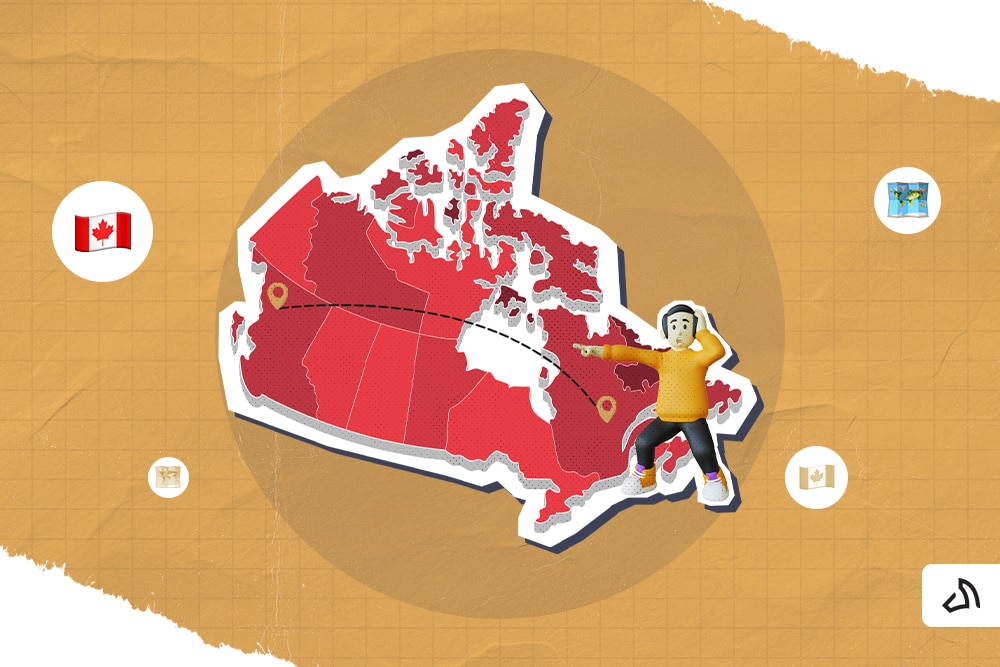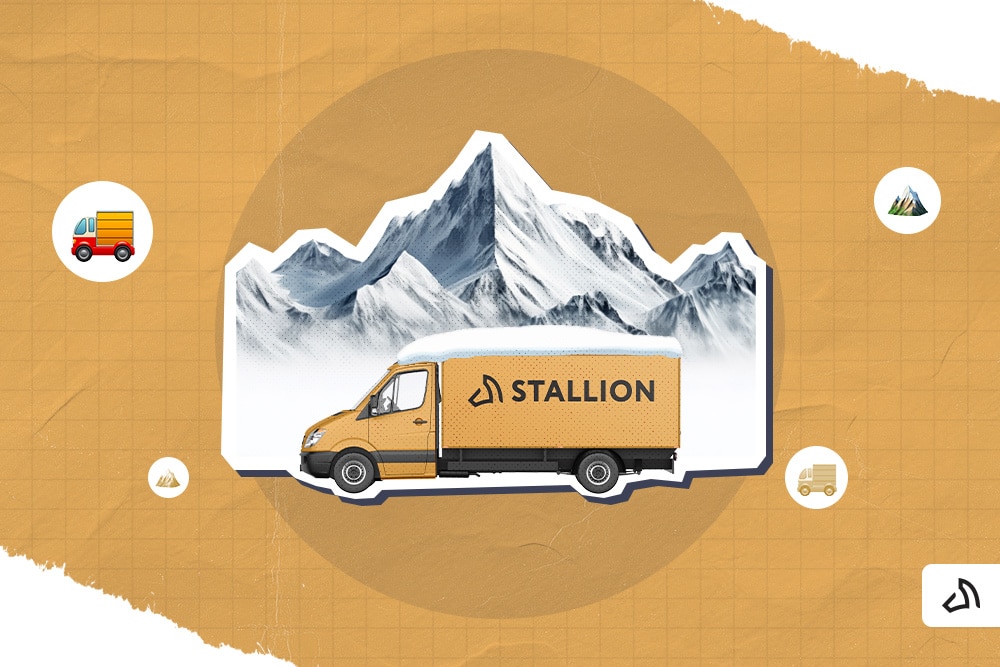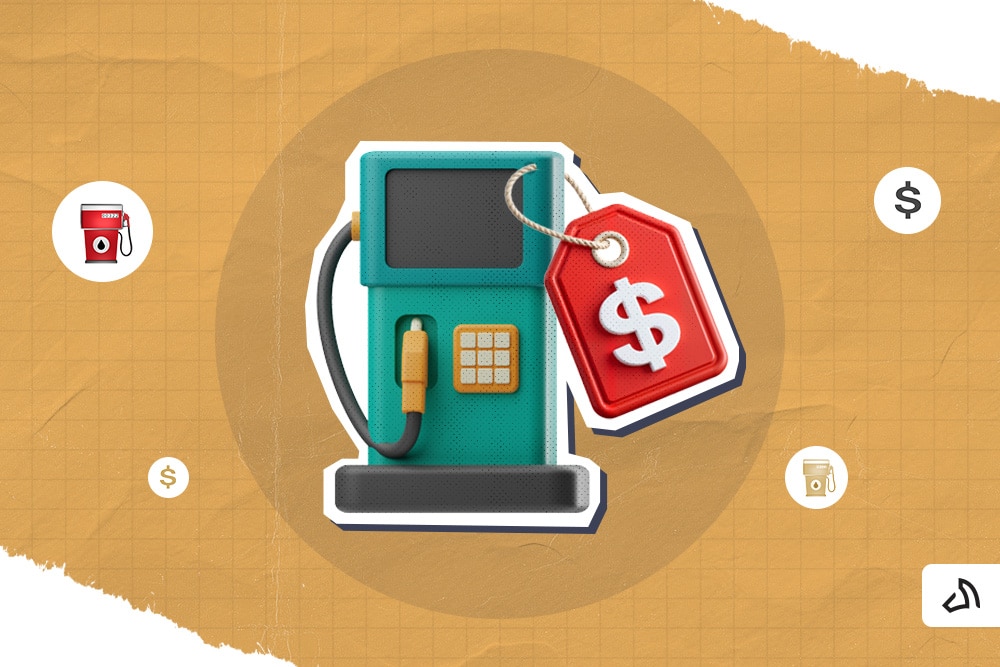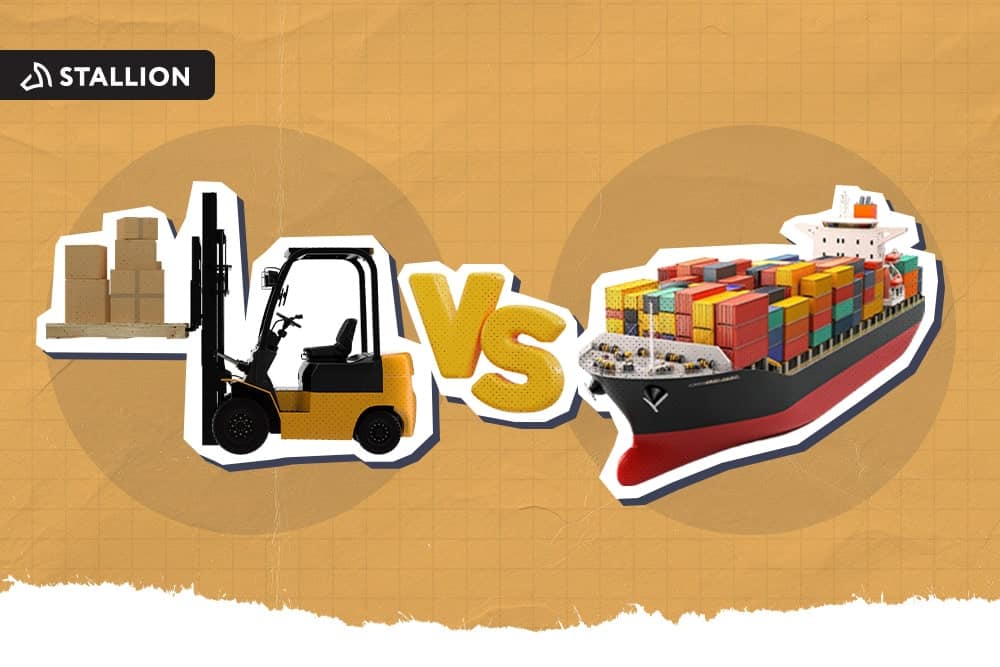
Finding the cheapest way to ship within Canada is a common concern, not just among Canadian online sellers but in the entire eCommerce industry. Since shipping plays a vital role in keeping your business afloat, it's crucial to consider all the aspects influencing it.
Leaf through this article to find the cheapest shipping method and other relevant information to improve your business margins and shipping strategy.
Let's dive in.
Ground shipping is the cheapest way to ship across Canada. While it may involve longer transit times than expedited shipping, it presents budget-friendly shipping costs, especially when immediate package shipping isn't needed.

Ground shipping using LTL (Less-than-truckload) carriers is the cheapest parcel shipping option for smaller items within Canada. By opting for ground shipping, you're capitalizing on cheap shipping while ensuring your packages reach their destination reliably. This method aligns perfectly with non-urgent domestic shipping.
We will discuss LTL and FTL in more detail below.

Freight shipping becomes an important factor to consider when sending large or heavy packages that exceed the capability of regular domestic shipping services. Major shipping companies like FedEx and UPS extend their services to include freight delivery, providing a workable alternative at a cost-effective option.
This alternative suits substantial or unwieldy items, aligning seamlessly with your shipping requirements while focusing on reliable yet cheap shipping options.
You can choose between these shipping services for freight:
LTL shipping is a shipping service presenting a practical solution when you ship parcels in relatively modest-sized freight. It involves transporting smaller loads that only require the capacity of part of the truck. Combining shipments into a single vehicle maximizes efficiency while optimizing space utilization and reducing shipping costs.
It is particularly advantageous for small businesses seeking to reduce shipping costs while accommodating varied shipment sizes. This approach emphasizes adaptability, efficiency, and affordability, and it perfectly satisfies the requirements of companies who handle different shipping volumes of freight without requiring a whole truckload of commitment.
FTL freight shipping is pivotal in the shipping and logistics landscape by catering to the movement of substantial cargo quantities that warrant using an entire trailer. This method benefits small businesses shipping high volumes of goods that can effectively utilize the total capacity of a truck.
With FTL shipping, the shipper bears the cost of the entire truck's utilization, making it the cheapest way to ship bulk quantities. This process is marked by its directness, where freight is transported from one shipping to a singular destination without additional stops or detours. It enhances efficiency and ensures the goods remain secure and intact throughout their journey.
Below are the major carriers' sample rates for their cheapest option for shipments from Toronto to Vancouver for a package weighing 1kg with measurements of 15cm x 8cm x 5cm:
| Carrier | Shipping Option | Pricing (CAD) | Transit Time |
|---|---|---|---|
| Canada Post | Regular Parcel | $28.05 | 7 business days |
| UPS | UPS Standard | $41.13 | 7 business days |
| FedEx | FedEx Ground | $42.84 | 6 business days |
| Purolator | Purolator Ground | $72.30 | 7 business days |
| Canpar | Canpar Ground | $75.19 | 4 business days (not guaranteed) |
| Stallion | UniUni | $7.15 | 2-4 business days |

Determining the right shipping cost can take time and effort for online retailers. It can lead to two things:
Several major carriers might offer free shipping, but they've planned this carefully. Suppose you want to do the same. In this case, plan things thoroughly and partner with trusted carriers. If you ship bulk packages, you might get a discount.
This amount can cover the free shipping you can provide to your shoppers! Nonetheless, calculate shipping costs so you can give instant customer quotes.
How can you calculate the rates? Simple!
This process involves setting shipping rates for each product and location. Though it requires effort, it builds trust and loyalty, boosting sales. Transparent shipping costs also enhance brand loyalty. So, providing varied shipping choices at different shipping rates can reduce cart abandonment, making customers feel in control and improving their shopping experience.
The four factors required to calculate shipping costs are:
Indicate the package's destination, including the city and ZIP code. Shipping providers use shipping zones to calculate shipping rates. Shipping zones measure the distance between a package's origin to its destination. They are calculated based on where your package is shipped from, which means that two different points of origin shipping to the same destination may be sent to completely different zones.
Generally speaking, the farther a package goes, the higher the shipping costs are.
Shipping providers use dimensional weight (DIM weight) to decide shipping rates based on package size. DIM weight is calculated by multiplying package dimensions and dividing by a standard divisor. Major carriers like Canada Post, FedEx, and UPS determine charges using actual or DIM weight, choosing the higher value.
When evaluating shipping costs, it's crucial to consider both size and weight because larger or heavier products cost more to send.
Being Canada's national postal service, let's use Canada Post as an example. It offers competitive shipping options for you to choose from, from expedited shipping to package tracking.
You have a few options for shipping within Canada:
Regular Parcel. This courier service provides affordable ground shipping for packages in Canada, with tracking and delivery confirmation.
Xpresspost. With Xpresspost, you get faster delivery within Canada, with tracking and on-time delivery guarantees.
Priority. This is the quickest domestic shipping service, monitoring on-time delivery guarantees and next-day delivery to most locations.
Flat Rate Shipping. You can expect delivery within a week with flat-rate shipping, but the shipping rates are not connected with the item's weight. This option allows you to ship up to 5 kg and includes package tracking.
Note - You can avail of highly discounted Canada Post rates through Stallion (versus going through Canada Post directly).
Additional options in shipping services can contribute to increased shipping costs. While these options provide valuable benefits, they come at an extra expense. Some other options include:
It's necessary to carefully evaluate these options based on your shipment's specific needs and their value to your customers' experience. You can make decisions aligning with your business objectives and shopper expectations by weighing the benefits they offer.
Before discussing the cheapest way of shipping packages nationwide, let's talk about the factors influencing the high shipping costs in Canada.

Canada's geographical size and considerable distances between origin and destination are the factors that affect the shipping costs. Travelling long distances directly translates into increased operating costs, leading to increased fuel consumption, as vehicles, ships, or aircraft spend more time in operation.
Apart from these geographical challenges, planning routes becomes complicated, needing extra facilities like rest stops and storage places, adding more expenses. Efficient navigation and following rules from different areas also add to operating costs, plummeting shipping costs due to Canada's big size and distance challenges.

Fewer customers translate to reduced shipping volumes in areas with low population density. This scarcity of demand leads to difficulties in spreading out the fixed transportation and logistics costs, causing individual shipping costs to rise.
As a result, most carriers need to raise their shipping rates to make up for the increased operating costs associated with each shipment. This further highlights the negative economic impact of Canada's low population density on the cost-effectiveness of the shipping service.
Small remote towns or less accessible areas need specialized transportation modes like air or sea freight, which are fundamentally more expensive than conventional road transport or ground shipping. Poor road conditions in certain regions can also lead to longer transit times and increased vehicle wear and tear, increasing maintenance costs.
Meanwhile, limited transportation infrastructure in northern territories results in fewer route options, reducing competition and raising shipping rates. Additionally, weather-related disruptions, especially during harsh winters, can cause delays and require additional resources for navigation and safety, adding to operational expenses.
These infrastructure-related obstacles collectively elevate the shipping price as shipping companies adjust to the specialized modes, manage maintenance challenges, and allocate resources to adjust to the unique demands of Canada's diverse landscape.

Harsh winters with heavy snowfall and icy conditions make travel difficult, resulting in delays and the need for expensive weather-related adjustments. These adverse weather conditions demand specialized equipment and safety measures, increasing operational expenses. Furthermore, bad weather can lead to rerouting, interrupting supply chains, and increasing fuel consumption and time demands.
On the other hand, shipping in extreme cold can affect vehicle performance and increase maintenance requirements and expenses. Coastal regions face challenges from maritime weather, requiring vessels to navigate turbulent waters, impacting schedules and potentially raising package insurance premiums.

The lack of shipping companies competing in Canada has reduced pressure to offer competitive rates, allowing major carriers to set higher prices without fear of losing customers. The absence of alternatives enables providers to maintain the shipping prices, especially in more secluded or less populated areas.
Due to the lack of market competition, fewer incentives exist to increase cost-
effectiveness and shipping service quality. Customers have fewer options to compare rates and services, resulting in less negotiating power.

The rising of global oil prices directly influences transportation expenses, as fuel accounts for a significant portion of operational costs. When oil prices rise, shipping companies face increased fuel expenses, increasing overall shipping prices. Moreover, Canada's vast geography amplifies the fuel costs effect, as longer distances require more fuel consumption. Plus, remote and northern areas often need specialized transportation modes that consume more fuel, compounding the expense.

Let's look at simple strategies to lower shipping expenses in your online store.
Optimize your packaging by using lightweight materials that guarantee product protection. By reducing dimensional weight charges, it lowers overall shipping costs without compromising the reliability of the shipments.
Consolidate multiple orders into a single shipment to save money. This approach capitalizes on bulk shipping rates, substantially lowering individual shipping costs and fostering efficient resource utilization while maintaining reliable delivery standards.
Set minimum purchase requirements for free shipping to encourage customers to make larger purchases. This method improves their shopping experience and reduces delivery costs due to the higher order value, encouraging cost-effectiveness and consumer satisfaction.
Consider choosing ground shipping over air freight when immediate delivery isn't vital. Ground options offer a cost-efficient alternative, as air freight generally charges higher. This prudent decision allows you to save time with budget considerations, optimizing shipping costs while maintaining service quality.

Experience budget-friendly domestic shipping solutions within Canada through Stallion. You can save money with our cost-effective options that cater to your needs while ensuring reliable and timely delivery. With Stallion, you can enjoy affordable rates and save money for your shipments, optimizing your shipping budget without compromising quality.
Whether you're sending packages locally or across provinces, Stallion focuses on economical solutions to make shipping hassle-free for eCommerce sellers shipping within Canada.

Candy Rada is a dedicated professional with tons of experience in content writing for the shipping industry. As a literature degree holder, she excels in creating engaging content with strategies that enhance brand visibility. She enjoys playing with her cats, reading dystopian books, and joining trivia games in her free time.



Can our fellow Torontonians relate?
-
#smallbusiness #business #entrepreneur #socialmedia #shipping #ecommerce #canadianecommerce #shopify #poshmark #b2b #saas #etsy #ebay #canada #canadiansmallbusiness #shoplocalcanada #entrepreneur
#toronto

Here’s your quick hassle free shipping from 🇨🇦 to 🇺🇸 as a business owner!
-
Any questions?! Leave them 👇🏻 and save this video so you don’t forget!
-
#smallbusiness #business #entrepreneur #socialmedia #shipping #ecommerce #canadianecommerce #shopify #poshmark #b2b #saas #etsy #ebay #canada #canadiansmallbusiness #shoplocalcanada #entrepreneur

Meet @drinkbenny a 🇨🇦 female founded energy drink brand! Instead of focusing on their products, they’re taking a unique approach by hosting in person events in different Canadian cities to offer an experience for their community 🧡
-
What are your thoughts on in person events? 💭
-
#smallbusiness #business #entrepreneur #socialmedia #shipping #ecommerce #canadianecommerce #shopify #poshmark #b2b #saas #etsy #ebay #canada #canadiansmallbusiness #shoplocalcanada #entrepreneur

Do you know the difference between DDU and DDP when shipping internationally 🌏 ?
-
Questions? Leave them below! 👇🏻
-
#smallbusiness #business #entrepreneur #socialmedia #shipping #ecommerce #canadianecommerce #shopify #poshmark #b2b #saas #etsy #ebay #canada #canadiansmallbusiness #shoplocalcanada #entrepreneur

Here’s a quick hack to save time from choosing multiple postage options
↪️ Turn on the lowest postage rate automation to save you time!
-
Questions? Leave them below! 👇🏻
-
#smallbusiness #business #entrepreneur #socialmedia #shipping #ecommerce #canadianecommerce #shopify #poshmark #b2b #saas #etsy #ebay #canada #canadiansmallbusiness #shoplocalcanada #entrepreneur
